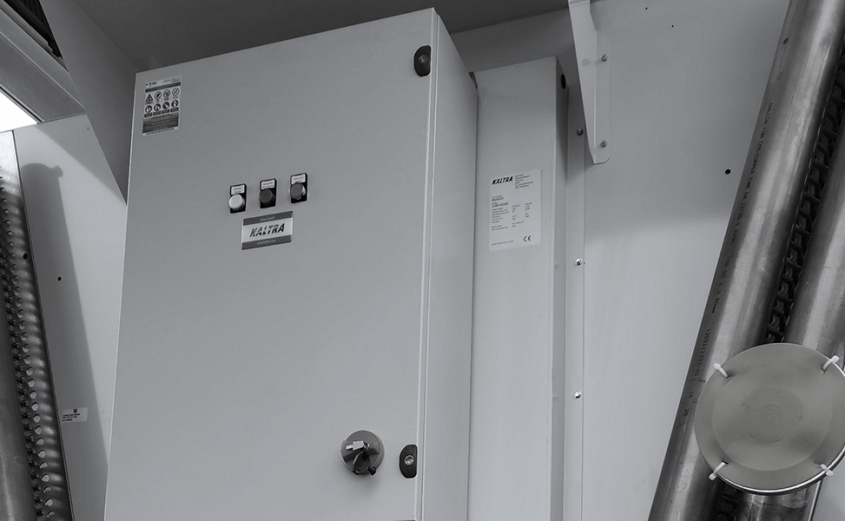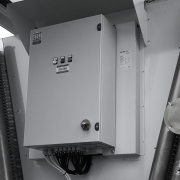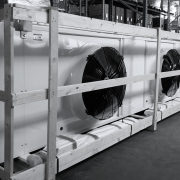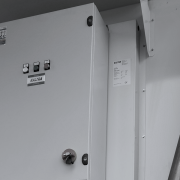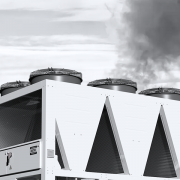Dry cooler selection: what do you need to know?
Introduction
Dry coolers are heat rejection devices used to cool down process liquids such as water, glycols, oils by forced dissipation of heat energy to the atmosphere. In contrast to wet cooling towers, dry coolers are closed-circuit systems, involving no direct contact between air and process fluid.
Dry coolers can be used as stand-alone fluid coolers or as a part of an air conditioning or refrigeration system to cool fluids in intermediate heat exchangers, water chillers’ evaporators, and for many other purposes.
Common dry cooler designs are flatbed units with either vertical or horizontal airflow direction or V-shaped units with one or two rows of axial fans with lateral air suction and discharge from the top.
Being used in many industrial and commercial applications, from chemical plants to data centers and shopping malls, dry coolers are relatively simple appliances consisting of two main component parts: air-to-liquid heat exchangers and fan blowers. Normally, used fans are of axial type, and heat exchangers are finned pack coils or, for small or medium systems, microchannel coils.
Dry cooler selection seems straightforward, and it generally is – until up-to-day customer requirements like optimized power consumption, reduced sound emission, or size limitations are taken into account in detail. Given the wealth of technical solutions for fans, heat exchangers, and assisting components like adiabatic pre-cooling, the task becomes even more complicated. Indeed, what should be taken into consideration when selecting a dry cooler for the modern and efficient cooling plant?
Baselines
The basic input for the selection process includes fluid inlet temperature, outlet fluid temperature (or flow rate), type of fluid to cool, and ambient air temperature. However, a number of other parameters and conditions should be considered:
- Unit collocation. Closely spaced units will likely have reduced performance. Drawing of hot exhausted air by nearby units should be avoided by providing sufficient distances between units or locating them on the gantry or frame of enough height. Small gaps between dry coolers must be covered with blind panels in the latter case.
- Prevailing wind direction and wind speeds. As strong winds may significantly affect performance, fencing of the installation site may be required – which may also isolate unit-borne noise.
- Altitude above sea level of the installation site affects fan performance.
- Fans shall be selected to withstand the temperature of air exhausted from heat exchangers.
- For operation under low ambient conditions, working fluid shall contain antifreeze in sufficient concentration to prevent freezing of heat exchangers and pipework. It is recommended to select AC-driven fans to operate at very low ambient temperatures.
- Fan noise. A good practice is to select EC-driven fans to reduce noise output, e.g., at night time, by limiting fan rotation speed. The soundproof fence is another effective method of noise reduction for the whole cooling plant. The soundproof fence is another effective method of noise reduction for the whole cooling plant.
- It is worth assessing expected daily/seasonal changes in cooling demand when selecting fan motor type. For instance, the use of EC-driven fans at partial loads enables up to 70% power savings compared to units equipped with AC-motor fans.
- Type of fan speed controls and regulating signals. Units may have their own independent fluid temperature sensors and fan speed controllers but may be incorporated in upper-level systems taking regulating signals from networked control devices.
- It may be necessary to introduce dry cooler controls to the upper-level BMS system. So the type of network protocol should be taken into consideration for controls options selection.
- Available water side pressure drop. Excessive pressure drop could lead to pump size and power draw increase.
- Electrical/control panel normally located directly on the unit; however, in some cases like installations in cold climates, it is mandatory to locate an electrical enclosure remotely, indoors, or using a stand-alone weatherproof structure.
- Fan blowers can be equipped with individual switch-offs for hot swapping or maintenance without the necessity of unit shutdown.
- Fluid connection type.
- Type of vibration dampers.
Process Fluids
Typical process liquids include water, mixtures of water and glycols, and oils/special fluids. In particular cases, for instance, when fluid may contain contaminants or its pH level is out of allowable (safe) range, various inhibitors should be used to prevent heat exchanger corrosion issues. In the former case, installing a strainer is imperative. Special protective heat exchanger inner coatings may also be a necessity for some kind of fluids.
Even if the process liquid temperature is high enough to operate safely in wintertime, antifreeze addition may be reasonable to avoid freezing in case of failures, blackouts, shortages in fluid supply, or cases of emergency repairs.
External pipework must include air vents – to eliminate oxidation, cavitation, and airlocks.
Fans
Fan Speed Control
Fan speed controllers maintain fluid outlet temperature setpoint for dry coolers under any given load by varying motor speed according to sensed fluid temperature. Fan regulation is a crucial issue, as, in fact, dry coolers are designed for maximum conditions – maximum ambient temperature and thermal load. In practice, maximum load in combination with maximum ambient temperature occurs for a very limited period of the year, making dry coolers oversized for a large part of the time. Fan regulation helps to reduce oversizing whilst contributing to energy savings and noise levels of the fan motors.
Several solutions exist for fan speed regulation:
- Fans with electronically-commutated (EC) motors. The speed control of an EC-motor is realized by an integrated commutation device by adjusting the position of the permanent-magnet rotor. Commutation circuits of EC-motors receive input with pulse-width modulation or, typically, 0-10V or 4-20mA from an external temperature sensor and regulate the speed in a range of 10% to 100%. EC fans offer maximum energy savings compared to other solutions, but the cost of the fan drive is higher than that for fans equipped with conventional AC motors.
- On-off control. This simple and cheap regulation system is based on sensing fluid outlet temperature and requesting turning on or off a certain number of fans according to effective capacity. On-off control offers low savings of power and limited noise reduction. In addition, fan on-off cycling adversely affects its operating lifespan.
- Cut-phase speed control. This type of controller modulates the speed of all fans simultaneously by reducing power voltage. It ensures considerable power savings and reduces noise output but has a downside in magnetic noise.
- Inverter speed control also efficiently regulates all fans together by changing frequency. While offering great power savings and noise reduction, the system is sophisticated and the most expensive of all others.
- Transformer-based speed controller provides very efficient regulation that does not generate magnetic noise. Offering high energy savings and sound reduction, however, motor service life can be reduced as a result of continuous low-voltage operation mode.
In modern systems based on AC-motor fans, the most popular solution is cut-phase speed control due to its price/quality ratio. EC-driven fans also became very popular, but their use in low ambient conditions is limited.
Sound Emission
Fan noise emission is directly related to rotation speed: the higher speed, the higher the noise output. Selecting fans with larger impellers capable of handling large air volumes results in decreased sound at the same airflow. EC-motor fans with regulated speed produce less noise at partial loads, e.g., at nighttime.
Beyond those, fan noise can be reduced with the use of diffusers, which, what is more, are increase the system efficiency. Diffusers that decelerate the flow and convert a large proportion of the dynamic kinetic energy into static pressure allow savings of up to 25% energy while enabling an operating noise level of up to 7 dB(A) lower with the same airflow.
Heat Exchangers
Large industrial dry coolers generally use finned pack coils made of copper (tubes) and aluminum (fins), while smaller size units can also be designed with all-aluminum microchannel cooling coils.
Coils require regular cleaning to maintain heat transfer performance. Cleaning is a delicate procedure as fins can be easily damaged by excessive pressure, and utmost attention should be devoted to fin thickness during dry cooler selection.
Tubeside pressure resistance of heat exchangers influences pump size and power draw: undue pressure drops, therefore, wherever possible, should be avoided.
Corrosion Protection
Corrosion is one of the main issues affecting heat exchangers and the most frequent cause of failures. The main reasons for this are lack of anti-corrosive treatment/coating and untimely cleaning.
Nowadays, a large variety of protective coatings are available, ranging from painting to trivalent chromium process to electrophoretic epoxy coating, differing by the level of protection and cost.
Due regard should be given to anti-corrosion treatments of cooling coils, particularly for coastal installations and installations in industrial/urban zones with high air pollution levels. Anti-corrosive treatment is also recommended for adiabatic-assisted systems. Coating selection should be based on identified pollutants and chemicals present in the air.
Freezing Protection
In low ambient conditions, ensure process fluid contains antifreeze in sufficient concentration to avoid freezing of heat exchangers and pipework. Antifreeze must be selected, bearing in mind its viscosity, toxicity, and other properties. The most widely used antifreeze fluids are glycols: ethylene or propylene glycol. Even if process fluid temperature is high enough, antifreeze fluids must be added for the cases of failure, maintenance, or downtimes caused by other factors.
Adiabatic-Assisted Cooling
Water Spray Systems
The water spray system provides an adiabatic cooling effect using intermittent atomized water spray on the inlet air stream, lowering air temperature closer to wet-bulb temperature, thus contributing to considerable energy savings and increased duty. The spray system requires water treatment; sprayed water cannot be collected for reuse, making this type of adiabatic pre-cooling water-intensive.
Evaporative Pre-Cooling
The same principle is true for evaporative pre-cooling, where incoming air stream passes through pads made of cellulose or other materials like aluminum foil wetted by (tap) water. Usually, water doesn’t need to be extensively treated and can be collected for reuse. On balance, evaporatively cooled units demonstrate significant energy savings on fans and increased heat rejection compared to conventional dry coolers.
Average local climate characteristics such as temperature and relative humidity should be taken into consideration to evaluate the seasonal and total efficiency of the above methods.
Maintenance
In order to minimize operating expenses and improve system reliability, it is necessary to evaluate the serviceability of dry coolers for certain installation of different designs: flatbed or V-shaped, with horizontal or vertical airflow.
Maintenance for dry coolers is relatively easy. Typical dry cooler maintenance tasks include:
- General inspection: finding any mechanical issues and damages, revealing excessive vibrations of fans, visual checking for traces of corrosion.
- Cleaning of cooling coils. General debris such as leaves, paper, dust, and pollen can be removed using a brush, with compressed air blowing against the direction of airflow. Heavier fouling must be removed using a pressure water/steam jet washer against airflow direction using a neutral cleaning agent if required. Any cleaning fluids should be suitable for both tube and fin materials and coatings. It must be noted that incorrect use of cleaning agents could be corrosive towards heat exchanger materials.
- Check for fluid leakages in heat exchangers and connections.
- Check electrical connections for tightness, check fan Amps consumption.
- Check control devices and probes.
***
Careful selection of the most suitable dry cooler and associated options should be predicated upon objective evaluation of the characteristics and requirements of the application and performed by HVAC professionals.
Software-assisted selection should be proven by technicians to assure that dry cooler specification is attuned to all details of the application and tailored for installation site, cost-effective, and future-proof.
P.S. If you are looking for a fluid cooling solution, we’d love to hear about it and pick up the most efficient and cost-effective dry coolers. Please get in touch with our team at [email protected].

